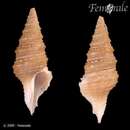tr
kırıntılardaki isimler


Gemmula, common name the gem turrids, is a genus of sea snails, marine gastropod mollusks in the family Turridae, the turrids.[2]
These snails have been recorded as fossils from the Paleocene to the Quaternary (from 66.043 to 0.012 Ma). Fossils have been found all over the world.[3]
This genus is still regarded as paraphyletic and should be revised.[4] A high number of undescribed species are estimated to belong to Gemmula. Since independent “Gemmula-like” lineages are distributed all over the turrid tree, a revision of Gemmula would entail again a complete revision of the family Turridae. [5]
They are venomous with disulfide-rich polypeptides in their venom ducts.[6] These bioactive peptides are likely to become a resource for novel pharmacologically active compounds [7]
The snails in this genus occur mostly in deeper tropical waters at depths between 50 and 500m. Because of these deep habitats, little is known about their feeding habits.
The Gemmula clade is more closely related to the clades Xenuroturris, Turris and Lophiotoma than to the other clades in the former subfamily Turrinae.
The fusiform shell resembles Drillia, but with a thin and simple outer lip without an anterior sulcus, and the inner lip usually simple, hardly callous. The protoconch is polygyrate and axially costate. There are three or four embryonal whorls, the two upper ones smooth, upright, the others longitudinally ribbed. The sculpture is most emphasized in a spiral direction, often with a prominent beaded keel at or in front of the anal fasciole.The rather long siphonal canal is narrow and tapering, sometimes curved. The sinus is straight, more or less narrow and long, terminating in a nodulous peripheral keel that is gemmate throughout. Type species : Pleurotoma gemmata Hinds, 1843 [8] [9]
The bead-row of the fasciole readily distinguishes this genus from related forms. Between the smooth protoconch and the adult whorls two or three whorls intervene with descrepant sculpture of fine arcuate longitudinal riblets. [10]
As expected from venomous species, these species have a toxoglosson radula (formula 1 + 0 +1 + 0 + 1) with a central tooth that characterizes this genus.[11]
The genus Gemmula is the largest genus in the former subfamily Turrinae. Species within the genus Gemmula include:
Gemmula, common name the gem turrids, is a genus of sea snails, marine gastropod mollusks in the family Turridae, the turrids.
These snails have been recorded as fossils from the Paleocene to the Quaternary (from 66.043 to 0.012 Ma). Fossils have been found all over the world.
This genus is still regarded as paraphyletic and should be revised. A high number of undescribed species are estimated to belong to Gemmula. Since independent “Gemmula-like” lineages are distributed all over the turrid tree, a revision of Gemmula would entail again a complete revision of the family Turridae.
 Fossil shell of Gemmula rotata from Pliocene
Fossil shell of Gemmula rotata from Pliocene They are venomous with disulfide-rich polypeptides in their venom ducts. These bioactive peptides are likely to become a resource for novel pharmacologically active compounds
Gemmula is een geslacht van weekdieren uit de klasse van de Gastropoda (slakken).
Gemmula is een geslacht van weekdieren uit de klasse van de Gastropoda (slakken).
Gemmula é um gênero de gastrópodes pertencente a família Turridae.[2]
Gemmula é um gênero de gastrópodes pertencente a família Turridae.
Гемула (Від лат. Gemmula — маленька брунька):
Гемула (Від лат. Gemmula — маленька брунька):
зимова внутрішня брунька у стані спокою в багатьох прісноводних (наприклад у губок бадяг) і деяких морських губок. Являє собою кулясте скупчення багатих поживними запасними речовинами амебоподібних клітин, діаметором близько 0,3 мм в мезоглії губки, оточене оболонкою з двох рогових (спонгінових) шарів (укріплених спікулами або амфідисками з кремнезему), між якими є повітроносні прошарки. У оболонці зазвичай є вихідний отвір, закритий перетинкою. Взимку, після відмирання і розпаду губки, гемули падають на дно водойми (добре переносять її промерзання і висихання). Навесні оболонка гемули лускає, клітинна маса звільняється, прикріплюється до дна водойми і розвивається в нову губку. Гемули поширюються течіями, водними тваринами і тощо Гіпотетічна одиниця спадковості в теорії пангенезу Чарльза Дарвіна.